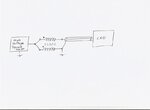T
treez
Guest
Hello,
Supposing I have an ETD39, N87, Epcos Ferrite transformer.
Ns = 30
Np = 30
I put the ungapped ETD39 core halves into the bobbin and measure the leakage inductance.
Now I do the same again, but this time with a 0.2mm centre leg gapped ETD39 core.
…Which of the above two leakage inductance measurements is greatest?
ETD39 Ferrite core datasheet
https://www.farnell.com/datasheets/1859555.pdf
Supposing I have an ETD39, N87, Epcos Ferrite transformer.
Ns = 30
Np = 30
I put the ungapped ETD39 core halves into the bobbin and measure the leakage inductance.
Now I do the same again, but this time with a 0.2mm centre leg gapped ETD39 core.
…Which of the above two leakage inductance measurements is greatest?
ETD39 Ferrite core datasheet
https://www.farnell.com/datasheets/1859555.pdf




